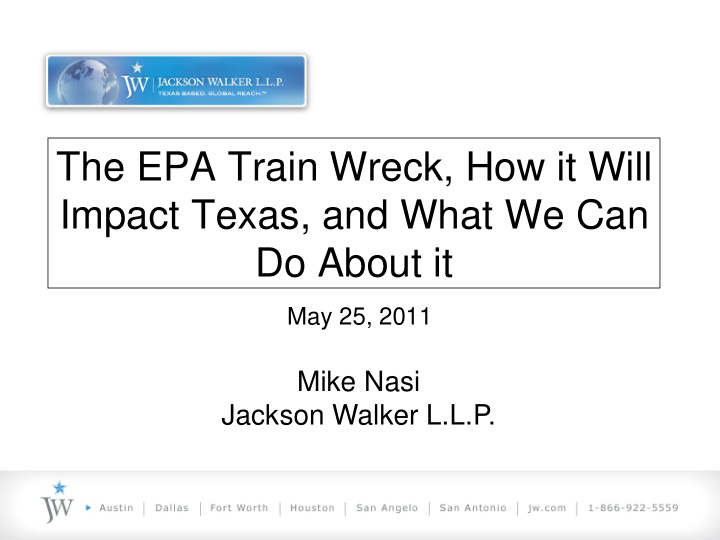



The EPA Train Wreck, How it Will Impact Texas, and What We Can Do About it May 25, 2011 Mike Nasi Jackson Walker L.L.P.
Presentation Outline The EPA Avalanche (continued. . . ) • EPA’s Coal Combustion Residuals Rule • EPA’s Utility MACT Rule • EPA’s Ozone Rule Risk to Texas’ Electric Generating Stability • Relative Resilience of the Texas Power Fleet • Meeting Regulatory and Consumer Electricity Demands • Diversity Means Security What Can Texas do to Prepare This Session and Beyond 2
EPA’s CCR Rule • Proposed June 2010; expected finalization by Spring/Summer 2012. • Two CCR Regulatory Options (Haz & Non-Haz). • Industry: $75 billion compliance cost. • EPA: $20 billion compliance cost (assumed recycling would increase, not decrease). • Bills working through Congress to prevent Haz option (over 40,000 comments submitted). • EPA’s own study found in 2005 that the biggest barrier to recycling was regulation as Haz waste. 3
CCR Beneficial Use The World’s Best Recycling Program 4
EPA’s Utility MACT Rule • Proposed May 2011; expected finalization by November 2011. • EPA’s proposal to regulate mercury and other hazardous air pollutants (HAP) from coal, lignite, and oil-fired power plants. • Texas has vast deposits of lignite and lignite-fired units that will be affected because of their type and variability of mercury. • Annual compliance costs by 2015: – EPA estimates cost of ~$11 billion. – Industry estimates cost of ~$100 billion. 5
Mercury Deposition – Foreign Sources Percent of mercury deposition that originates outside of the U.S. Source: EPRI 6
EPA’s Ozone Rule • Proposed January 2010; projected finalization by August 2011. • 85 ppb limit was replaced in 2008 with 75ppb limit. • Current proposal revokes 2008 limit and will replace with limit between 60-70 ppb. • Monitored U.S. counties that would violate primary standard: – 70 ppb: 515 counties (76% of monitored) – 65 ppb: 608 counties (90% of monitored) – 60 ppb: 650 counties (96% of monitored) • State Nonattainment Designations Due: January 2012 (tentative) • State SIP Revisions Due: August 2014 (tentative) • EPA predicts cost of compliance up to $90 billion. 7
Nonattainment for 85 ppb (1997 Standard) Beaumont- Port Arthur: Hardin, Jefferson, Orange Dallas-Fort Worth: Collin, Dallas, Denton, Ellis, Johnson, Kaufman, Parker, Rockwall, Tarrant Houston-Galveston- Brazoria: Brazoria, Chambers, 85 ppb Fort Bend, Galveston, Harris, Liberty, Montgomery, Waller 8 8
Nonattainment for 75 ppb (2008 standard) ADD: Bexar El Paso (non-tribal) Gregg Hood Rusk 85 ppb 75 ppb Smith Travis 9 9
If new standard set at 70 ppb ADD: Harrison Hunt Nueces 85 ppb 75 ppb 70 ppb 10 10
If new standard set at 65 ppb ADD: Brewster Hays Victoria 85 ppb 75 ppb 70 ppb 65 ppb 11 11
If new standard set at 60 ppb ADD: Cameron Hidalgo (Metropolitan Statistical Areas also represented on map) MSAs 70 ppb 85 ppb 65 ppb 75 ppb 60 ppb 12 12
Risk to Texas Electric Generating Stability • Despite relative resilience of Texas power plants, suite of EPA regulations will have significant effect on Texas. • NERC Predicts 5-6 GW of retirements in Texas by 2015. • ERCOT Predicts 9.3 GW of retirements in Texas by 2017. – 1,200 MW of coal – 8,100 MW of gas • ERCOT estimates only a 0.2% reserve margin after retirements (13.75% is the current mandated reserve). • Any interference with the expansion of the Texas power fleet will endanger electric reliability and price stability. • Texas must and will fight back given how high the stakes are to our economy and electric reliability & affordability. 13
14 Source: Balanced Energy for Texas (BET)
15 Source: BET
16 Source: BET
17 Source: BET
What Can Texas do to Prepare This Session and Beyond? • Defend Texas against takeover attempts by EPA regarding the SIP. • Challenge new regulations that have costs that are not outweighed by their benefit. • Work with Congressional Delegation to start constraining EPA’s overreach. • Address Texas program inefficiencies to ensure that we don’t shoot ourselves in the foot. 18
Self-Help Example: Avoiding Procedural Logjams to Power Plant Retrofit Timelines • Texas’ air permit process could delay installation of federally-mandated controls: – By requiring long permit process for pollution reduction projects; – By forcing existing plants to go through contested-case evidentiary hearing process, even though EPA does not have or require such a contested cases process. • Note: The Clinton EPA eliminated evidentiary hearing procedures because it found them to be: “unnecessary procedures which do not provide any environmental benefits.” 65 Federal Register 30886. 19
20 Source: BET
Recommend
More recommend